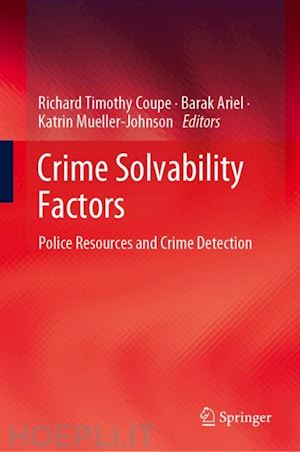
Questo prodotto usufruisce delle SPEDIZIONI GRATIS
selezionando l'opzione Corriere Veloce in fase di ordine.
Pagabile anche con Carta della cultura giovani e del merito, 18App Bonus Cultura e Carta del Docente
At a time when resources are scarce, not every crime may be investigated as fully as is desirable. Police generally use experience to guide their case screening. This volume demonstrates a new, research-based approach, exploring innovative research on crime solvability as a factor for crime investigation and prevention.
Crime solvability is the interplay between forensic science, decision-making, and prediction to determine the likelihood that a crime will be solved. This text discusses recent studies of how solvable cases may be identified, using original sets of police data. It focuses on high-volume crimes such as burglary, assault, metal theft, and cyberfraud. By targeting more cases that can be solved, police departments can manage their resources better and have the greatest effect on arrests, as well as preventing future crimes by these offenders.Topics covered include:
Crime Solvability Factors: Police Resources and Crime Detection will be of interest to researchers in criminology and criminal justice, particularly with an interest in quantitative and experimental research and police studies. It will also be of interest to policymakers and police organizations.
Chapter 1: Introduction.- Chapter 2: Existing Research on Solvability.- Chapter 3: Population-Level Analysis of Residential Burglaries.- Chapter 4: Assessing Solvability Factors in Greater Manchester, England: The Case of Residential Burglaries.- Chapter 5: Solvability Indicators for ‘First Officers’: Targeting Eyewitness Questioning at Non-Residential Burglaries.- Chapter 6: Pickpocketing on Railways.- Chapter 7: Metal Theft Solvability and Detection.- Chapter 8: Detecting and Combating Internet Telephony Fraud.- Chapter 9: Targeting Factors that Predict Clearance of Non-Domestic Assaults.- Chapter 10: Solvability Factors and Investigative Strategy for Faith Hate Crime: Anti-Semitic and Islamophobic Assault, Criminal Damage and Public Order Offences in London.- Chapter 11: Reporting, Detection and Solvability of Sex Offences on Railways.- Chapter 12: Offender–Offence Profiling: Improving Burglary Solvability and Detection.- Chapter 13: Boosting Offence Solvability and Detections: Solving Residential Burglaries by Predicting Single Repeat and Multiple Repeats.- Chapter 14: Improving Offence Solvability and Detection Rates at Non-Residential Burglary: Predicting Single Repeat and Multiple Repeat Incidence.- Chapter 15: Homicide Resources, Solvability and Detection.- Chapter 16: Investigative Activities, Resources and Burglary Detection.- Chapter 17: The Organisation and Deployment of Patrol Resources: Cost-Effective On-Scene Arrest at Burglaries.- Chapter 18: Resources, Solvability and Detection: A Theoretical Model.- Chapter 19: Conclusions.
Timothy Coupe researches and lectures criminal justice management, crime investigation and detection in the Institute of Criminology at Cambridge University. He previously worked in operational research, computing science, business management and urban and regional planning. He has been involved in applied research into improving policing performance for the U.K. Home Office and with police services in the U.K., Sweden, Denmark and Australia. He has consultancy experience in a variety of public organisations and commercial companies on the cost-effective use of resources and improving efficiency. He is an advocate of the benefits of using scientific analysis and prediction to complement professional experience for improving the way organisations are managed.
Barak Ariel is a lecturer in the Police Executive Programme. Among other topics, Barak provides seminars on research methods, systematic reviews and statistical analyses. As the chief analyst of the Jerry Lee Centre of Experimental Criminology, Barak is involved in several field experiments on police tactics in partnership with forces in the UK and abroad, including hotspot policing, restorative justice, use of cameras in police operations, informal crime control, and tax compliance. Barak is working in collaboration with Professor Lawrence Sherman and Dr. Heather Strang on Restorative Justice Trials, as well as in collaboration with Professor David Farrington on blocked randomised experiments. Barak is also working on a series of systematic reviews for the Campbell Collaboration, as well as other methodological issues related to experiments in Criminology.
Katrin Mueller-Johnson is a Senior Lecturer in Applied Criminology at the Institute of Criminology at the University of Cambridge.










Il sito utilizza cookie ed altri strumenti di tracciamento che raccolgono informazioni dal dispositivo dell’utente. Oltre ai cookie tecnici ed analitici aggregati, strettamente necessari per il funzionamento di questo sito web, previo consenso dell’utente possono essere installati cookie di profilazione e marketing e cookie dei social media. Cliccando su “Accetto tutti i cookie” saranno attivate tutte le categorie di cookie. Per accettare solo deterninate categorie di cookie, cliccare invece su “Impostazioni cookie”. Chiudendo il banner o continuando a navigare saranno installati solo cookie tecnici. Per maggiori dettagli, consultare la Cookie Policy.